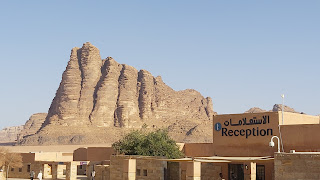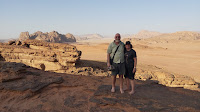Jordan Pilgrimage Day 2 - A hot day in Petra
Day two began so early, but with delicious omelets. The breakfast buffet includes an omelette chef who makes your omelette to order from a range of wonderful ingredients. No better way to start the day.
And then at seven we gathered ready for our morning at Petra. This is the official website as well. It was cool, and quiet, not many people yet. We were guided down the road by our guide, Michel, towards Al-Siq, the narrow passage made so famous by Indiana Jones and the Last Crusade.
 We paused as we passed the Djinn Blocks and Obelisk Tomb and the Bab
as-Siq Triclinium. At the entrance to Al-Siq was a Nabatean dam built after
devastating floods to prevent further flooding and to aid in the capture of
water that was then fed into Petra City down water channels.
We paused as we passed the Djinn Blocks and Obelisk Tomb and the Bab
as-Siq Triclinium. At the entrance to Al-Siq was a Nabatean dam built after
devastating floods to prevent further flooding and to aid in the capture of
water that was then fed into Petra City down water channels.
 The Treasury on Indiana Jones was a temple, but in reality,
it is a tomb. What you see is the elaborate facade to a not very deep “cave”.
This amazing carved edifice, and all the others we encountered as we walked
down to the amphitheatre, are all the tombs of very important people, mostly
rulers it is thought. From the Nabataean histories they are reasonably confident
at naming who several of the tombs were built to house in death.
The Treasury on Indiana Jones was a temple, but in reality,
it is a tomb. What you see is the elaborate facade to a not very deep “cave”.
This amazing carved edifice, and all the others we encountered as we walked
down to the amphitheatre, are all the tombs of very important people, mostly
rulers it is thought. From the Nabataean histories they are reasonably confident
at naming who several of the tombs were built to house in death.
 |
| view from Urn Tomb |
 |
| Royal Tombs |
 |
| roof of Urn Tomb |
 |
| Crowded entrance to Al-Siq on the way out |
just coughed and barge my way back into the Siq. I needed a cold Fanta when I got back and had a little time to explore the visitor centre and some of the history and art including the famous gravestone head art. My other option for the painting was this, and I wish I had got that, but too late for buyer’s remorse.
You can find my Facebook photos I put up at the time here.
 |
| Seven Pillars of Wisdom - Wadi Rum |
“Sharif Hussein’s objective in undertaking the Great Arab Revolt was to establish a single independent and unified Arab state stretching from Aleppo (Syria) to Aden (Yemen), based on the ancient traditions and culture of the Arab people, the upholding of Islamic ideals and the full protection and inclusion of ethnic and religious minorities. Arab nationalists in the Fertile Crescent and the Arabian Peninsula found in the Hashemite commanders of the Great Arab Revolt the leadership that could realize their aspirations, and thus coalesced around them.” (http://www.kinghussein.gov.jo/his_arabrevolt.html)
That promise was not kept, but his sons did become the first kings of Iraq and Transjordan. The Hashemites kings of Jordan continue today. But it is a very messy story and the consequences of European empire building after WW1 continue to be played out today. Wadi Rum played an important role in the revolt. It is where
the movie “Lawrence of Arabia” was filmed, and Lawrence’s memoir “7 Pillars of
Wisdom” is named after a rock formation seen as you enter this desert.
Wadi Rum played an important role in the revolt. It is where
the movie “Lawrence of Arabia” was filmed, and Lawrence’s memoir “7 Pillars of
Wisdom” is named after a rock formation seen as you enter this desert.
This is a very different desert from the Judean Wilderness. This is sand with rock formations rising out of that sand. We climbed into 4-wheeled drives and drove through this sandy wilderness with an army of other 4-wheel drives in front and behind. We stopped for ancient graffiti at on ancient trader’s caravans stopping point. We climbed another rock formation which gave great views of the Wadi. I discovered that people have not walked on sand before, a strange notion for any person from Aotearoa. I knew to walk in the footsteps of those who had climbed before me. But one of the Americans did not know this, but watched me and learnt. And then I ran down the soft sand bouncing and running in a way I have not done for years. O the joy!

We stopped where the hidden camp of the revolt is thought to have been. It had a rock with both Lawrence and Emir Faisal’s faces carved into it. Some say Lawrence created these. I had my photo taken next to Lawrence’s carved face. In the 7th form I played the Ottoman General had Lawrence raped to break his spirit and break the revolt. Sorry.
 And then we arrived
at our glamping site – Sun City Camp. There are so many of these sites.
Permission is not being given for hotels in the wadi, so these glamping sites
that cater for all price brackets are popping up. We had a lovely,
air-conditioned tent and the hottest on-suite you can imagine. Dinner was cooked
in the ground in what looked like concrete pits. Each night pretty girls are
asked to help the staff open the cooking pit, scraping the sand off the top and
lifting the heavy lid. But as they lift out jumps one of the staff, who has been
hiding in there for some time.
And then we arrived
at our glamping site – Sun City Camp. There are so many of these sites.
Permission is not being given for hotels in the wadi, so these glamping sites
that cater for all price brackets are popping up. We had a lovely,
air-conditioned tent and the hottest on-suite you can imagine. Dinner was cooked
in the ground in what looked like concrete pits. Each night pretty girls are
asked to help the staff open the cooking pit, scraping the sand off the top and
lifting the heavy lid. But as they lift out jumps one of the staff, who has been
hiding in there for some time.  Great hilarity. And then the food comes out:
meat, veges and rice cooked on rocks – a Bedouin hangi! We moved to the dining
room for dinner. Delicious. And maybe a little unsafe? More about that in the
next post.
Great hilarity. And then the food comes out:
meat, veges and rice cooked on rocks – a Bedouin hangi! We moved to the dining
room for dinner. Delicious. And maybe a little unsafe? More about that in the
next post.After dinner the Bedouin staff put on a show of dances, getting others up to join them. It was a warm and clear night. A great end to an amazing day.
You can find my Wadi Rum photos on Facebook here.
Being in Petra was such a privilege. It is amazing, the story of it is so rich and yet so many know nothing about it. I was so glad Michel took us early, beating the heat and the crowds. And going to Wadi Rum was such fun, linking me back to 17-year-old me playing my wee part in the school play. A day I am reminded of each time I look at the Bedouin on my wall.










Comments